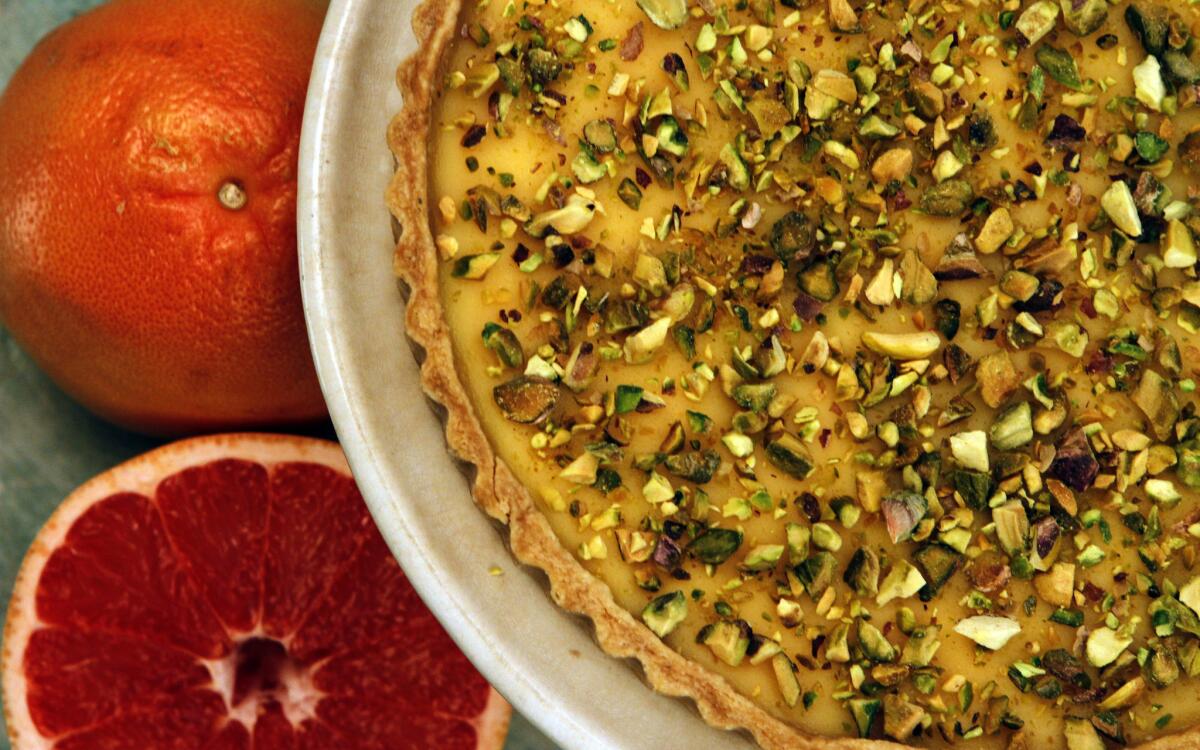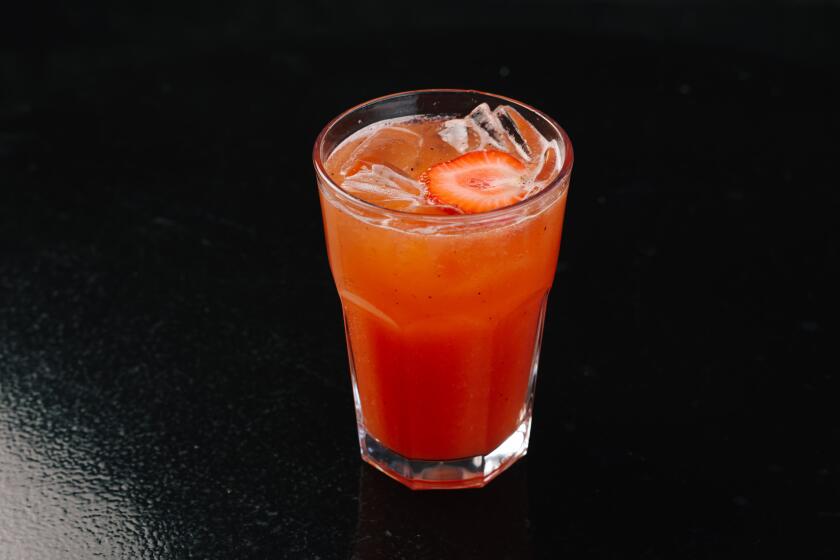Tart with grapefruit curd and Campari

- Share via
I’m writing this column having just spent an hour with our local fruit gleaner picking tangelos from my tree. We must have pulled at least 40 pounds. Earlier in the day, I’d picked an additional three dozen pieces of fruit for recipe testing. And the danged tree still looks like it hasn’t been touched.
This time of year in Southern California is an embarrassment of citrus riches. We’ve got so many tangerines, oranges, lemons, grapefruits and tangelos in my neighborhood that it seems impossible to figure out what to do with them all.
One solution, of course, is gleaning -- that’s where volunteers harvest backyard fruit for donation to food charities. There are several such organizations in Southern California; Food Forward is one very good one.
Then, of course, you can always eat what’s left. Here’s the odd thing, though: Considering how much citrus we have just hanging around, there aren’t nearly enough ways to use them. Unlike oranges, tangerines and grapefruit, recipes don’t grow on trees.
So once you’ve tired of peeling all that fruit and eating it out of hand, what do you do? Here are a few ideas:
One of my favorite ways to serve citrus is in a fruit salad. This isn’t your grandma’s mixture (or maybe it is, if she was a really good, slightly fussy cook), and it’s really too simple to justify a full recipe.
Peel and slice the fruit into wheels -- the more types the merrier, so you’ll get a nice combination of colors and sizes. Then just dress them with a simple syrup made of sugar cooked with water until it’s clear. Use 1/2 cup to 2/3 cup sugar for every cup of water, depending on your taste.
Well, it doesn’t have to be quite that simple. Steep herbs or spices in the syrup while it’s cooking. Vanilla is almost always a great match for citrus; cloves are too. And adding just a little honey adds a sweet muskiness.
Or you can get really creative and use different kinds of teas. Camomile adds an herbal note. If you can find a really nice jasmine tea, that adds a spectacular floral fragrance. This weekend, I finished a big meal with a salad of blood, Cara Cara and navel oranges in a syrup flavored with orange zest and a good pinch of smoky Lapsang souchang tea. That’s one I’ll definitely use again.
Just be gentle with the seasoning; you want to accent the flavor of the citrus, not disguise it.
Citrus sorbets are just one step more complicated, and they’re terrific either by themselves or in combination with fruit salad. Start with that flavored simple syrup again -- this time equal parts water and sugar. You’ll want about 3 cups of syrup for every cup of juice. Freeze it in an ice cream maker or in a cake pan in the freezer -- the crystals will be coarser, but that’s refreshing sometimes.
Be sure to include lots of zest in the syrup. One thing to remember when cooking with citrus is that there is a big difference in flavor between the juice and the zest. You’ll almost always want to use a combination.
The juice primarily carries the simple flavors of the fruit -- sweetness and tartness plus the broad character of the variety. The zest, where the fruit’s oils are, carries the complex flavors. You can extract them by simmering the zest in a syrup or by simply crushing it with sugar. A bowl and a spoon work just fine for this; just rub the peel and sugar together until the sugar is saturated with the color of the fruit.
One thing that does make it easier to find recipes to use up citrus is that, even though the various fruits are quite distinctly different, they can be used more or less interchangeably in cooking. If you’ve got a favorite orange sorbet, you can easily use grapefruit to get a different but very good dessert.
The one exception to this that comes to mind is the blood orange. Because the anthocyanin pigment that gives the orange its crimson color is heat-volatile, cooking blood oranges for very long can result in an ugly bruised purple rather than that spectacular sunset color. I only use blood oranges raw.
Curds are another remarkably flexible way to use citrus. You can use them as sauces, as fillings for tarts and as frosting layers for cakes. Or, if you’re feeling really indulgent, you can even eat them straight out of the bowl as a kind of super-luxurious pudding. In fact, that’s how my wife and I finished off the leftovers of this grapefruit-Campari curd the other night, with just a sugar cookie.
Curds are fascinating. Try heating eggs, butter, sugar and water together, and you’ll get a really awful version of wet, sweet scrambled eggs. Replace the water with citrus juice and you get this amazing thick cream.
What’s the difference? The acidity in the citrus juice raises the temperature at which the egg proteins coagulate, so instead of scrambling solid, they link up just enough to trap the melted butter.
There are all kinds of recipes for curds varying from the puckeringly tart to the extremely buttery. My favorite is on the buttery side but with still a pucker and fruit character.
You won’t believe how simple it is to make: Basically, you just heat citrus juice and zest with a combination of whole eggs and egg yolks, sugar and butter until it thickens. You do need to keep stirring the whole time, but it takes only about five minutes.
If that’s too complicated, even easier to make is the lemon tart Mary Constant posted on the Food52 website. In a blender, puree a whole seeded lemon -- yes, that’s right, the whole thing, peel and pith and all -- and blend eggs, vanilla and sugar until the mixture’s smooth. Pour it into a tart shell and bake.
It’s delicious -- kind of a spin on the old dessert called Shaker lemon pie, but instead of slicing the lemons paper-thin, you just puree them.
Another supremely easy citrus dessert is this pudding from my friend Deborah Madison’s book “Seasonal Fruit Desserts,” a real treasure chest of great ideas.
Simply simmer 2 cups of citrus juice, along with zest and sugar, with 3 tablespoons of cornstarch (that seems like a lot, but the acidity of the citrus reduces the thickening power of the cornstarch).
Cook it just past the point where it boils, stir in flavorings (honey and orange flower water or yuzu juice are what she recommends, but there’s plenty of room for experimentation) and chill.
The result is creamy and rich feeling but has very few calories -- of course, it’s better when topped with a little whipped cream, but that’s up to you.
Because let’s face it, when life hands you lemons like we’re getting now, it would be a shame to settle for lemonade.
Heat the oven to 350 degrees. Prick the bottom of the tart shell lightly with a fork, line it with parchment or aluminum foil and fill it with pie weights (you can use dried beans and save them to use as weights the next time you bake). Place the tart shell on a baking sheet and bake until the rim of the tart is dried and set, about 15 minutes (timing may vary depending on the dough or brand). Remove the weights and the aluminum foil and return the tart shell to the oven to bake until it is well browned, about 30 more minutes. Set aside to cool slightly.
Meanwhile, prepare the filling. In a small heavy-bottomed saucepan, beat the whole eggs, egg yolks, salt and sugar until smooth and light colored. Add the grapefruit juice, zest, Campari and butter and cook over medium heat, stirring constantly, until the butter melts, about 5 minutes.
Reduce the heat to medium-low and continue cooking until the curd is thick enough that it coats the back of a spoon and that when you draw your finger across the curd it leaves a definite track, about 5 minutes. The curd should be as thick as thick hollandaise. Remove from heat.
Pour the curd through a strainer into the pre-baked tart shell and chill until firm. Sprinkle the chopped pistachios over the top before serving.
Get our Cooking newsletter.
Your roundup of inspiring recipes and kitchen tricks.
You may occasionally receive promotional content from the Los Angeles Times.
















